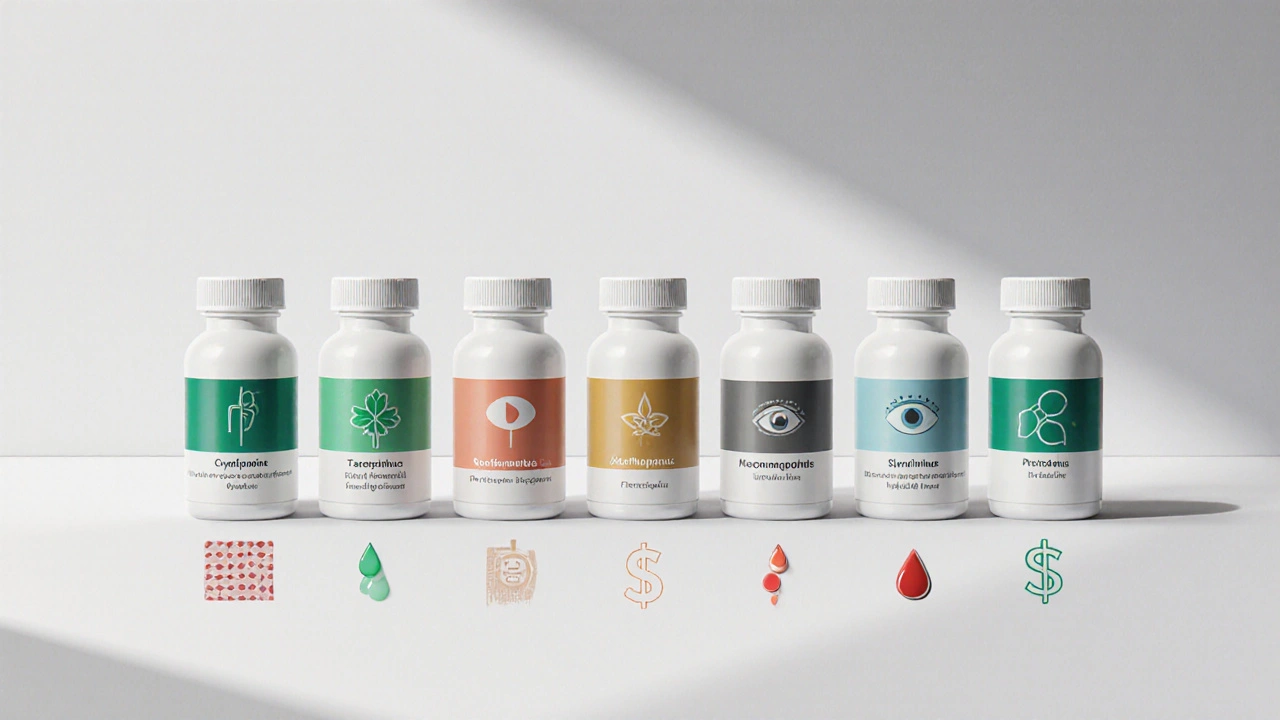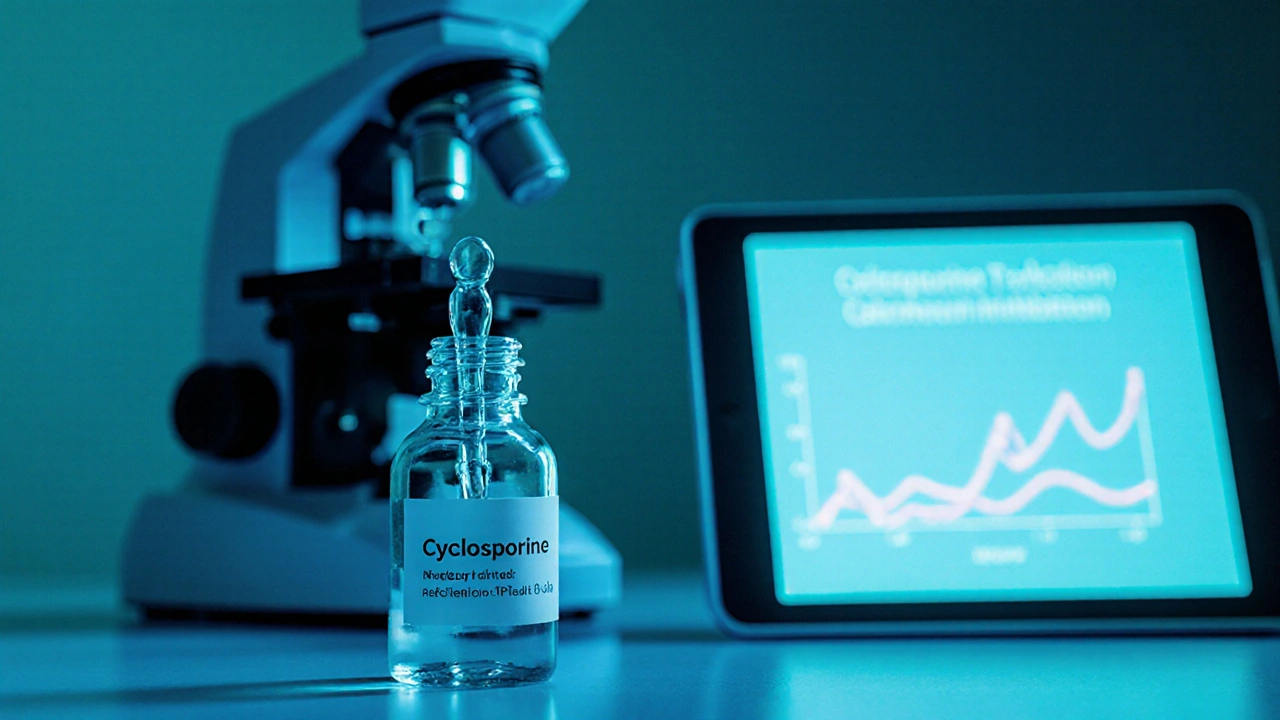Immunosuppressant Comparison Tool
Drug Comparison Table
| Name | Class | Primary Uses | Dose Range | Major Side Effects | Monitoring Needs | Annual Cost |
|---|
Drug Profile Details
Select a drug from the table to view detailed information.
Clinical Recommendations
Based on selected condition and sorting criteria, recommendations will appear here.
Cyclosporine is a calcineurin inhibitor that suppresses the immune system by blocking T‑cell activation. It’s been a cornerstone drug for organ‑transplant patients and certain autoimmune skin disorders since the 1980s.
- Know the key differences in mechanism, side‑effects, and cost.
- Pick the right alternative for transplant, dermatology, or eye disease.
- Understand monitoring requirements for each option.
- Get a quick lookup table for dose ranges and major risks.
- Use a practical checklist before switching therapies.
Why compare Cyclosporine with other immunosuppressants?
Doctors and patients often wonder if there’s a safer, cheaper, or more convenient drug that can do the same job. The answer depends on three jobs to be done:
- Assess how each drug works at the cellular level.
- Weigh efficacy against side‑effect burden for a given condition.
- Factor in dosing convenience, monitoring load, and out‑of‑pocket cost.
Below you’ll find a side‑by‑side look at the most common alternatives, plus a decision guide that tells you which is best for specific clinical scenarios.
Quick snapshot of the main players
Each drug is introduced with a short definition that includes the most relevant attributes - mechanism, approved uses, typical dose, big‑ticket side effects, monitoring, and cost range (U.S. average wholesale price, 2024).
Cyclosporine is a calcineurin inhibitor used to prevent organ rejection and treat severe psoriasis and uveitis. Typical oral dose: 2-5mg/kg/day divided BID. Major side effects: nephrotoxicity, hypertension, gingival hyperplasia. Blood level monitoring required. Annual cost: $1,200-$2,500.
Tacrolimus is a potent calcineurin inhibitor often preferred for kidney and liver transplants. Usual dose: 0.1-0.2mg/kg/day divided BID. Notable risks: diabetes, neurotoxicity, increased infection risk. Requires trough level monitoring. Annual cost: $2,000-$3,500.
Mycophenolate mofetil is an antimetabolite that blocks lymphocyte proliferation. Standard dose: 1-1.5g twice daily. Side‑effects: GI upset, leukopenia, increased infection risk. No drug‑level monitoring needed, but CBC checks are essential. Annual cost: $1,800-$2,800.
Sirolimus (also called rapamycin) is an mTOR inhibitor used in kidney transplant protocols and for some cancers. Dose: 2mg daily, adjusted to trough levels. Side‑effects: hyperlipidemia, delayed wound healing, edema. Requires blood level checks. Annual cost: $3,000-$4,500.
Azathioprine is a purine analogue that suppresses DNA synthesis in immune cells. Typical dose: 1-3mg/kg/day. Risks: bone‑marrow suppression, liver toxicity, teratogenicity. No routine level monitoring, but CBC/LFTs every 2-4 weeks. Annual cost: $600-$1,200.
Everolimus is an mTOR inhibitor closely related to sirolimus, approved for heart‑transplant and certain tumors. Dose: 0.75mg twice daily; trough‑guided. Side‑effects mirror sirolimus plus mouth ulcers. Annual cost: $4,000-$5,500.
Corticosteroids (e.g., Prednisone) are broad‑spectrum anti‑inflammatories used short‑term during transplant induction. Dose varies widely (5‑60mg/day). Side‑effects: weight gain, osteoporosis, glucose intolerance. No drug‑level monitoring, but long‑term use discouraged due to systemic effects. Annual cost: <$200.
Belatacept is a costimulation blocker given IV for kidney transplant maintenance. Dosed 10mg/kg on day 0, 14, 28, then monthly. Risks: post‑transplant lymphoproliferative disorder, infections. No blood‑level monitoring, but regular labs required. Annual cost: $7,000-$9,000.
Side‑by‑side comparison table
| Drug | Mechanism | Primary Indications | Typical Dose | Major Side Effects | Monitoring | 2024 Avg. Annual Cost (USD) |
|---|---|---|---|---|---|---|
| Cyclosporine | Calcineurin inhibition | Kidney, liver, heart transplant; psoriasis; uveitis | 2-5mg/kg/day BID | Nephrotoxicity, hypertension, gingival hyperplasia | Blood trough level (100‑400ng/mL) | $1,200-$2,500 |
| Tacrolimus | Calcineurin inhibition (more potent) | Kidney, liver, pancreas transplant; atopic dermatitis | 0.1-0.2mg/kg/day BID | Diabetes, neurotoxicity, infections | Blood trough level (5‑15ng/mL) | $2,000-$3,500 |
| Mycophenolate mofetil | Inhibits IMP dehydrogenase | Kidney, heart transplant; lupus nephritis | 1-1.5g BID | GI upset, leukopenia, infections | CBC/LFTs; no drug level | $1,800-$2,800 |
| Sirolimus | mTOR inhibition | Kidney transplant; certain cancers | 2mg daily (adjusted to level) | Hyperlipidemia, delayed wound healing | Blood trough level (5‑15ng/mL) | $3,000-$4,500 |
| Azathioprine | Purine synthesis blockade | Kidney transplant; IBD; rheumatoid arthritis | 1-3mg/kg/day | Bone‑marrow suppression, hepatotoxicity | CBC/LFTs every 2-4weeks | $600-$1,200 |
| Everolimus | mTOR inhibition (more lipophilic) | Heart transplant; neuroendocrine tumors | 0.75mg BID (level‑guided) | Mouth ulcers, hyperlipidemia | Blood trough level (3‑8ng/mL) | $4,000-$5,500 |
| Prednisone (corticosteroid) | Broad anti‑inflammatory, glucocorticoid receptor agonist | Induction therapy for transplant; autoimmune flares | 5-60mg/day (tapered) | Weight gain, osteoporosis, hyperglycemia | No drug level; monitor glucose, bone density | <$200 |
| Belatacept | Costimulation blockade (CTLA‑4 Ig) | Kidney transplant maintenance | 10mg/kg IV on day0,14,28, then monthly | PTLD, infections, infusion reactions | Regular labs; no level monitoring | $7,000-$9,000 |
Deep dive: When is Cyclosporine still the best pick?
For patients who need a proven, well‑studied drug with a relatively low acquisition cost, cyclosporine shines in two niches:
- **Eye disease** - especially non‑infectious uveitis where topical forms are available.
- **Psoriasis** - the oral formulation works where biologics are unaffordable or contraindicated.
Both scenarios benefit from routine blood‑level monitoring that keeps toxicity in check. If a patient already tolerates the drug without renal issues, switching may add unnecessary risk.
Alternative #1 - Tacrolimus: The more potent sibling
Tacrolimus offers stronger calcineurin inhibition, which translates to lower rejection rates in kidney transplants. However, it carries a higher chance of post‑transplant diabetes and neuro‑symptoms (tremor, headache). The drug is pricier and still needs trough‑level checks.
**Best for**: Patients with a history of cyclosporine‑related hypertension or gingival hyperplasia, and those who can tolerate its metabolic side‑effects.
Alternative #2 - Mycophenolate mofetil: The antimetabolite champion
Mycophenolate is often combined with a calcineurin inhibitor to allow lower doses of both, reducing nephrotoxicity. Its biggest downside is GI upset and a higher infection rate due to leukopenia.
**Best for**: Patients with stable kidney function who need a steroid‑sparing regimen, especially in lupus nephritis or heart transplant where lower calcineurin dosing is desired.

Alternative #3 - Sirolimus / Everolimus: mTOR pathway blockers
These drugs avoid the classic calcineurin‑related kidney damage, making them attractive for patients with pre‑existing renal impairment. Unfortunately, they delay wound healing-so they’re not ideal right after surgery. Sirolimus and everolimus also raise cholesterol and triglycerides, requiring lipid management.
**Best for**: Patients with chronic kidney disease who are past the immediate post‑op period, or for certain cancers where mTOR inhibition adds anti‑tumor benefit.
Alternative #4 - Azathioprine: The low‑cost, low‑monitoring option
Azathioprine is cheap and doesn’t need drug‑level checks, but its bone‑marrow toxicity can be a show‑stopper. It also works slower than calcineurin inhibitors, so it’s rarely used alone for high‑risk transplants.
**Best for**: Maintenance therapy after the first year post‑transplant, especially in patients who have stable renal function and can handle regular CBC monitoring.
Alternative #5 - Belatacept: The IV cost‑effective outlier
Belatacept eliminates calcineurin‑related nephrotoxicity but comes with a steep price tag and a rare but serious risk of post‑transplant lymphoproliferative disorder (PTLD), especially in EBV‑negative patients.
**Best for**: EBV‑positive kidney‑transplant recipients who need to avoid long‑term nephrotoxicity and can manage regular infusions.
Practical decision checklist
- Is the primary concern **renal toxicity**? → Consider sirolimus, everolimus, or belatacept.
- Do you need **rapid, strong immunosuppression**? → Tacrolimus or cyclosporine are first‑line.
- Is **cost** the limiting factor? → Azathioprine or prednisone are cheapest; mycophenolate is moderate.
- Any history of **diabetes or metabolic syndrome**? → Avoid tacrolimus and consider cyclosporine or mTOR inhibitors.
- Patient prefers **oral dosing** versus IV? → Belatacept out.
After you tick the relevant boxes, match the profile with the table above to see which drug aligns best with the patient’s clinical picture.
Monitoring tips for each agent
- Cyclosporine: Check trough levels 1‑2weeks after dose changes; monitor creatinine, BP, and magnesium.
- Tacrolimus: Same schedule but aim for lower target range; add fasting glucose checks.
- Mycophenolate: CBC and liver enzymes every month for the first 3months, then quarterly.
- Sirolimus/Everolimus: Trough levels monthly for the first 3months, lipid panel every 2months.
- Azathioprine: CBC and LFTs every 2weeks initially, then every 1‑2months.
- Prednisone: Blood glucose, bone density (if >3months), and eye pressure.
- Belatacept: CBC, LFTs, and EBV PCR quarterly.
Key takeaways
Choosing the right immunosuppressant isn’t about picking the “best” drug in absolute terms; it’s about matching the drug’s profile to the patient’s risk factors, cost constraints, and treatment goals. Cyclosporine remains a solid, affordable option for specific skin and eye conditions, but for many transplant patients newer agents can reduce kidney strain or metabolic side‑effects-if the budget allows.
Frequently Asked Questions
Can I switch from cyclosporine to tacrolimus without a wash‑out period?
Usually you can transition directly, but doctors often lower the cyclosporine dose a few days before starting tacrolimus to avoid overlapping nephrotoxicity. Blood levels of the new drug are checked within 3‑5days.
Why does cyclosporine cause gum overgrowth?
The drug stimulates fibroblast activity in the gingiva, leading to overgrowth. Good oral hygiene and regular dental visits can keep it manageable; dose reduction often helps.
Is mycophenolate safe for pregnant women?
Mycophenolate is teratogenic and classified as CategoryD. Women of child‑bearing potential must use reliable contraception and switch to a safer alternative before conceiving.
How often do I need blood‑level checks for sirolimus?
After the initial dose‑adjustment phase, trough levels are typically measured monthly for the first 3months, then every 2‑3months if stable.
What’s the biggest cost driver for belatacept?
The drug itself carries a high wholesale price, and because it’s given intravenously, infusion center fees add to the total expense.
